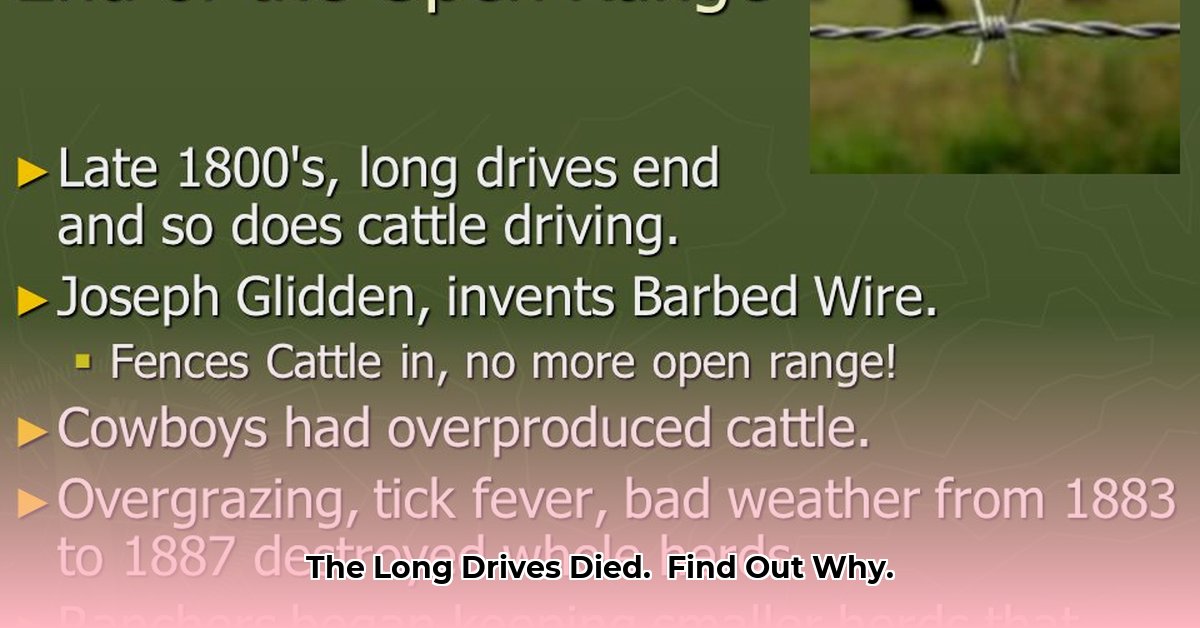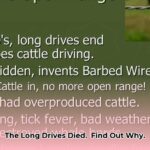The iconic image of cowboys herding cattle across the vast American plains is deeply embedded in American culture. However, this era of long drives eventually met its end. This article explores the multifaceted factors that contributed to the decline of this practice and the subsequent transformation of the cattle industry.
The Convergence of Factors: Technology, Economics, and Environment
The end of the long drive wasn’t a singular event, but rather a confluence of technological innovations, economic shifts, and environmental pressures. Understanding this interplay is crucial to grasping the evolution of ranching in the American West.
The Rise of the Railroad and Barbed Wire
Two pivotal inventions irrevocably altered the landscape of the cattle industry: the railroad and barbed wire. Railroads offered a faster, more cost-effective method of transporting cattle to eastern markets, negating the necessity for arduous, time-consuming drives. Simultaneously, barbed wire empowered ranchers to enclose their land, effectively dismantling the open-range system.
Railroads: Transporting cattle via rail significantly reduced transit times and expenses, making long drives economically unviable. This shift not only expedited the process but also minimized weight loss in cattle, leading to higher profits. Refrigerated cars further revolutionized the industry, allowing for the transport of dressed beef, further diminishing the need for live cattle drives.
Barbed Wire: This readily available and affordable fencing material revolutionized land management. Ranchers could now control their herds, manage grazing patterns, and prevent conflicts with neighboring ranchers and farmers. This shift towards defined property lines marked a profound change in the social and economic dynamics of the West.
Economic Volatility and Environmental Degradation
The cattle industry also grappled with significant economic and environmental challenges. Overgrazing, inherent in the open-range system, depleted grasslands, rendering them susceptible to drought and erosion. Fluctuating beef prices added to the instability, while severe winters, notably the “Big Die-Up” of 1886-1887, exposed the vulnerability of open-range ranching. This catastrophic winter decimated herds, forcing ranchers to re-evaluate their practices and consider more sustainable approaches.
Shifting Towards Sustainability: The Rise of Modern Ranching
The decline of long drives catalyzed a shift towards more sustainable ranching practices. Smaller, enclosed ranches became the norm, promoting better land management and herd control. While the concept of “sustainable agriculture” wasn’t fully articulated, this transition effectively laid the groundwork for modern ranching principles. Rotational grazing, improved breeding techniques, and a focus on animal health emerged as key elements of this new era.
Ranching in the Modern Era: Adapting to a Changing Landscape
The lessons learned from the demise of the open range hold crucial relevance for modern ranchers. Today’s challenges include climate change, fluctuating market conditions, and increasing consumer demand for sustainably produced beef.
Embracing Sustainable Practices for a Resilient Future
Modern ranching emphasizes sustainability through practices like rotational grazing, water conservation, and integrated pest management. These methods not only enhance environmental stewardship but also improve profitability and long-term viability. By prioritizing animal welfare and land health, ranchers can build resilient operations that contribute to a healthier ecosystem and a more secure food supply.
Technological Advancements: Precision Ranching and Data-Driven Decision-Making
Technology plays an increasingly crucial role in modern ranching. Precision ranching techniques, utilizing data analysis and sensor technology, allow for optimized resource management and improved animal health. These advancements empower ranchers to make informed decisions, enhancing productivity and minimizing environmental impact.
Collaboration and Consumer Engagement: Building a Sustainable Future
A collaborative approach involving ranchers, consumers, policymakers, and researchers is essential for ensuring a thriving future for the ranching industry. Educating consumers about sustainable ranching practices and fostering transparency within the supply chain builds trust and strengthens the market for sustainably produced beef. By working together, we can create a future where ranching contributes to both economic prosperity and ecological health.
- Red Cloud, NE: Discover Willa Cather’s Legacy - April 11, 2025
- Remember Old Social Media Sites? Their Rise and Fall - April 11, 2025
- How many days till Feb 3?Accurate Countdowns & Tools - April 11, 2025
















